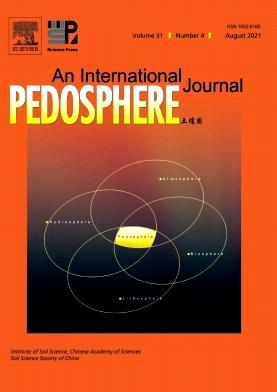洞察粘土有机矿物界面的矿渣强化热解吸作用
IF 5.2
2区 农林科学
Q1 SOIL SCIENCE
引用次数: 0
摘要
钢渣中的多种活性成分可以优化土壤质地,并催化难降解有机污染物,特别是多环芳烃(PAHs)的热解吸。本研究对收集的钢渣中存在的有毒金属进行了安全性和风险评估,并选择了XG钢铁厂(XGRS)中游离cao含量较高的精炼渣,用于调节粘土的塑性指数(PI)。对于高液限高塑性粘土(CH),当钢渣添加比为10%(质量百分比)时,其热物性指数从34.3%降至24.8%;对于低液限粘土(CL),其热物性指数从22.8%降至16.5%。在350°C时,随着土壤含水量从0增加到150 g kg - 1,由于粘土矿物的水化和溶胀以及脱羟基和脱水引起的热损失,CH中PAHs的热去除率从81.9%下降到74.0%。当添加2%(质量百分比)的CaO时,由于粘土矿物的脱水(氧)化延迟,土壤有机质的芳构化增强,效率进一步下降到68.7%。添加2%高含钛渣(HTBS)可提高高环多环芳烃的去除率,5环的去除率由52.6%提高到59.7%,6环的去除率由76.6%提高到81.8%。这是由于HTBS中存在无定形TiO2和结晶CaTiO3,可以降解水产生活性氧。添加2% XGRS有助于空气补充的晶格氧完全去除多环芳烃,导致CH中的C - C键氧化成C - O、C=O和O - C=O官能团。本研究为使用添加剂通过激活氧和氧化粘土中有机-矿物复合体中的C-C键来增强多环芳烃污染粘土的热修复提供了有价值的见解。本文章由计算机程序翻译,如有差异,请以英文原文为准。
Insight into slag-enhanced thermal desorption at the organo-mineral interface of clay soils
Multiple active components in steel slags can optimize soil texture and catalyze the thermal desorption of refractory organic pollutants, especially polycyclic aromatic hydrocarbons (PAHs). In this study, a safety and risk assessment was conducted on toxic metals present in collected steel slags, and the refining slag with a high content of free-CaO from the XG iron and steel plant (XGRS) was selected and used to regulate the plasticity index (PI) of clay soils. For the clay soil with high liquid limit and high plasticity (CH), the PI reduced from 34.3% to 24.8% with steel slags at an addition ratio of 10% (mass percent), and for the clay soil with low liquid limit (CL), the PI decreased from 22.8% to 16.5%, resulting in silt soil with optimal thermal properties. The thermal removal efficiency of PAHs in CH decreased from 81.9% to 74.0% at 350°C as the soil water content increased from 0 to 150 g kg−1, due to the hydration and swelling of clay minerals and the heat loss associated with dehydroxylation and dehydration. The efficiency further decreased to 68.7% using 2% (mass percent) CaO as an additive due to the delayed dehydr(oxyl)ation of clay minerals and enhanced aromatization of soil organic matter. In contrast, addition of 2% high-content titania-bearing slag (HTBS) enhanced the removal efficiency of high-ring PAHs, with the efficiency increasing for 5-ring from 52.6% to 59.7% and for 6-ring from 76.6% to 81.8%. This is due to the presence of amorphous TiO2 and crystalline CaTiO3 in HTBS, which can degrade water to produce reactive oxygen species. The 2% XGRS addition facilitated the complete removal of PAHs by air-supplemented lattice oxygen, leading to the oxidation of C–C bonds in CH to C–O, C=O, and O–C=O functional groups. This study provides valuable insights into the use of additives to enhance the thermal remediation of PAH-contaminated clay soils via activating oxygen species and oxidizing C–C bonds in organo-mineral complexes within clay soils.
求助全文
通过发布文献求助,成功后即可免费获取论文全文。
去求助
来源期刊

Pedosphere
环境科学-土壤科学
CiteScore
11.70
自引率
1.80%
发文量
147
审稿时长
5.0 months
期刊介绍:
PEDOSPHERE—a peer-reviewed international journal published bimonthly in English—welcomes submissions from scientists around the world under a broad scope of topics relevant to timely, high quality original research findings, especially up-to-date achievements and advances in the entire field of soil science studies dealing with environmental science, ecology, agriculture, bioscience, geoscience, forestry, etc. It publishes mainly original research articles as well as some reviews, mini reviews, short communications and special issues.
 求助内容:
求助内容: 应助结果提醒方式:
应助结果提醒方式:


